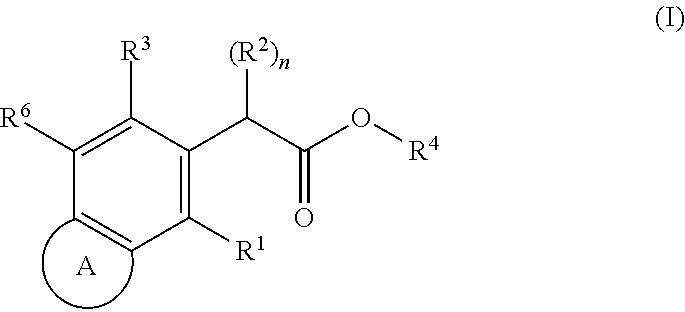HIV replication inhibitor
- Summary
- Abstract
- Description
- Claims
- Application Information
AI Technical Summary
Benefits of technology
Problems solved by technology
Method used
Image
Examples
example 1
Synthesis of Compound 3
First Step Synthesis of Compound (2)
[0763]Compound (1) (6.50 g, 16.0 mmoL) was dissolved in DMF (50.0 mL), and a solution of NBS (3.10 g, 17.6 mmoL) in DMF (10.0 mL) was added dropwise thereto at 0° C. After being stirred at same temperature for 10 minutes, the mixture was poured into ice water and extracted with ethyl acetate. The obtained organic layer was washed with brine, dried over anhydrous sodium sulfate, and concentrated under reduced pressure. The obtained residue was purified by silica gel column chromatography (petroleum ether-ethyl acetate) to obtain Compound (2) (5.10 g, 65%) as a yellow solid.
[0764]1H NMR (CDCl3) δ: 0.97 (s, 9H), 2.06-2.09 (m, 5H), 2.28 (s, 314), 2.69-2.83 (m, 2H), 3.66 (d, 3H), 4.23 (s, 2H), 5.01 (d, 1H), 6.78-6.87 (m, 2H), 6.98 (m, 1H).
[0765]LC / MS (ESI): m / z=476 [M+H]+.
Second Step Synthesis of Compound (3)
[0766]Compound (2) (150 mg, 0.315 mmoL) was dissolved in dichloromethane (2.00 mL), and triethylamine (0.044 mL, 0.315 mmoL...
example 2
Synthesis of Compound 7
[0772]
First Step Synthesis of Compound (6)
[0773]Compound (5) (100 mg, 0.309 mmoL) was dissolved in dichloroethane (2 mL), acetic acid (0.0350 mL, 0.619 mmoL) and benzylamine (0.0340 mL, 0.309 mmoL) were added thereto, the mixture was stirred at 60° C. for 3 hours 35 minutes. The mixture was cooled at room temperature, and sodium triacetoxyborohydride (103 mg, 0.464 mmoL) was added thereto, and the mixture was stirred at room temperature for 16 hours 15 minutes. The mixture was poured into the mixture of ice water and a saturated aqueous solution of sodium hydrogen carbonate and extracted with ethyl acetate. The obtained organic layer was washed with brine, dried over anhydrous sodium sulfate, and concentrated under reduced pressure. The obtained residue was purified by silica gel column chromatography (hexane-ethyl acetate) to obtain Compound (6) (175 mg, >100%) as a pale yellow oil.
[0774]1H NMR (CDCl3) δ: 1.22 (s, 9H), 2.27 (s, 3H), 2.36 (s, 3H), 3.58 (s, 2H)...
example 3
Synthesis of Compound 16
[0786]
First Step Synthesis of Compound (12)
[0787]Compound (11) (300 mg, 0.844 mmol) which was synthesized by the same manner as Compound (33), 1,2-dibromobenzene (199 mg, 0.844 mmol), xantphos (37 mg, 0.063 mmol), cesium carbonate (550 mg, 1.69 mmol) and Pd2 (dba)3 (39 mg, 0.042 mmol) were added to toluene (3 ml), and the mixture was heated to reflux for 18 hours under nitrogen atmosphere. The mixture was poured into water and extracted with ethyl acetate. The obtained organic layer was washed with brine, dried over anhydrous sodium sulfate, and concentrated under reduced pressure. The obtained residue was purified by silica gel column chromatography to obtain Compound (12) (282 mg, 66%) as a colorless foam.
[0788]MS: m / z=510, 512 [M+H]+
Second Step Synthesis of Compound (13)
[0789]Compound (12) (276 mg, 0.541 mmol), palladium acetate (12 mg, 0.054 mmol), potassium carbonate (149 mg, 1.08 mmol), tricyclohexylphosphonium tetrafluoroborate (40 mg, 0.11 mmol) were ...
PUM
| Property | Measurement | Unit |
|---|---|---|
| Composition | aaaaa | aaaaa |
| Antimicrobial properties | aaaaa | aaaaa |
Abstract
Description
Claims
Application Information
 Login to View More
Login to View More - R&D
- Intellectual Property
- Life Sciences
- Materials
- Tech Scout
- Unparalleled Data Quality
- Higher Quality Content
- 60% Fewer Hallucinations
Browse by: Latest US Patents, China's latest patents, Technical Efficacy Thesaurus, Application Domain, Technology Topic, Popular Technical Reports.
© 2025 PatSnap. All rights reserved.Legal|Privacy policy|Modern Slavery Act Transparency Statement|Sitemap|About US| Contact US: help@patsnap.com



